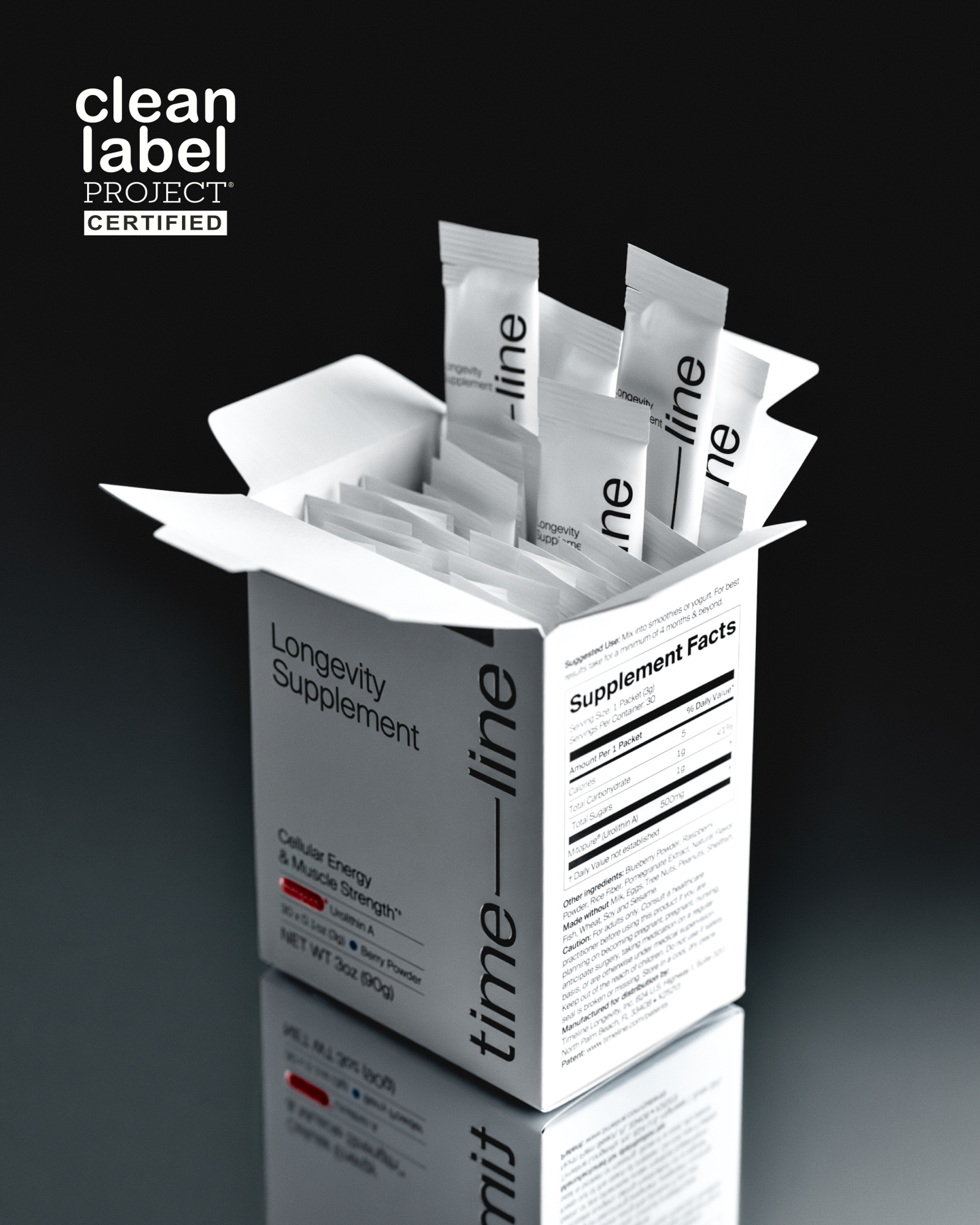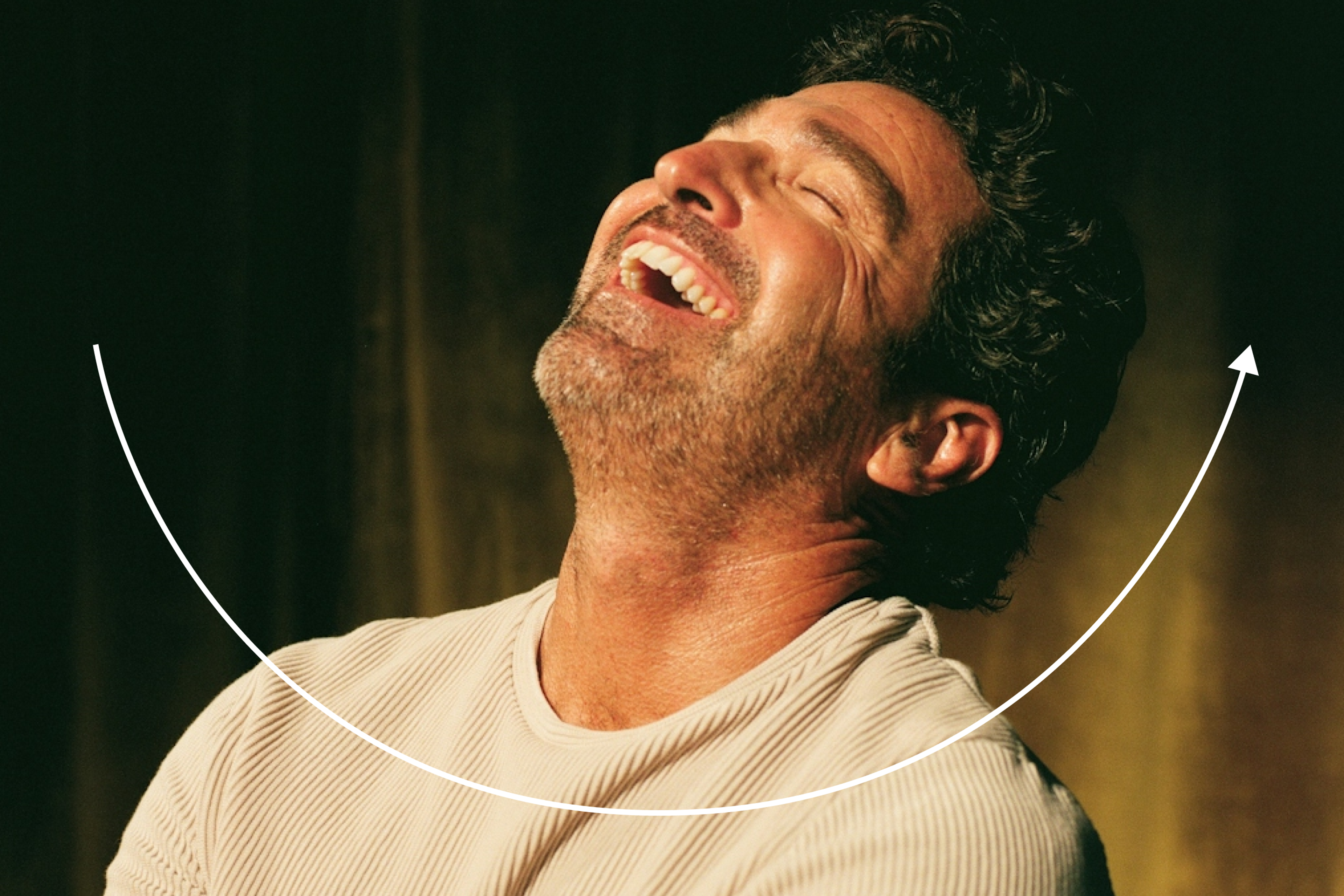Key Insights from Dr. Anurag Singh on Dave Asprey’s Podcast
Dive into mitochondrial health with Dr. Anurag Singh and Dave Asprey, exploring the science behind longevity, energy, and cellular rejuvenation.
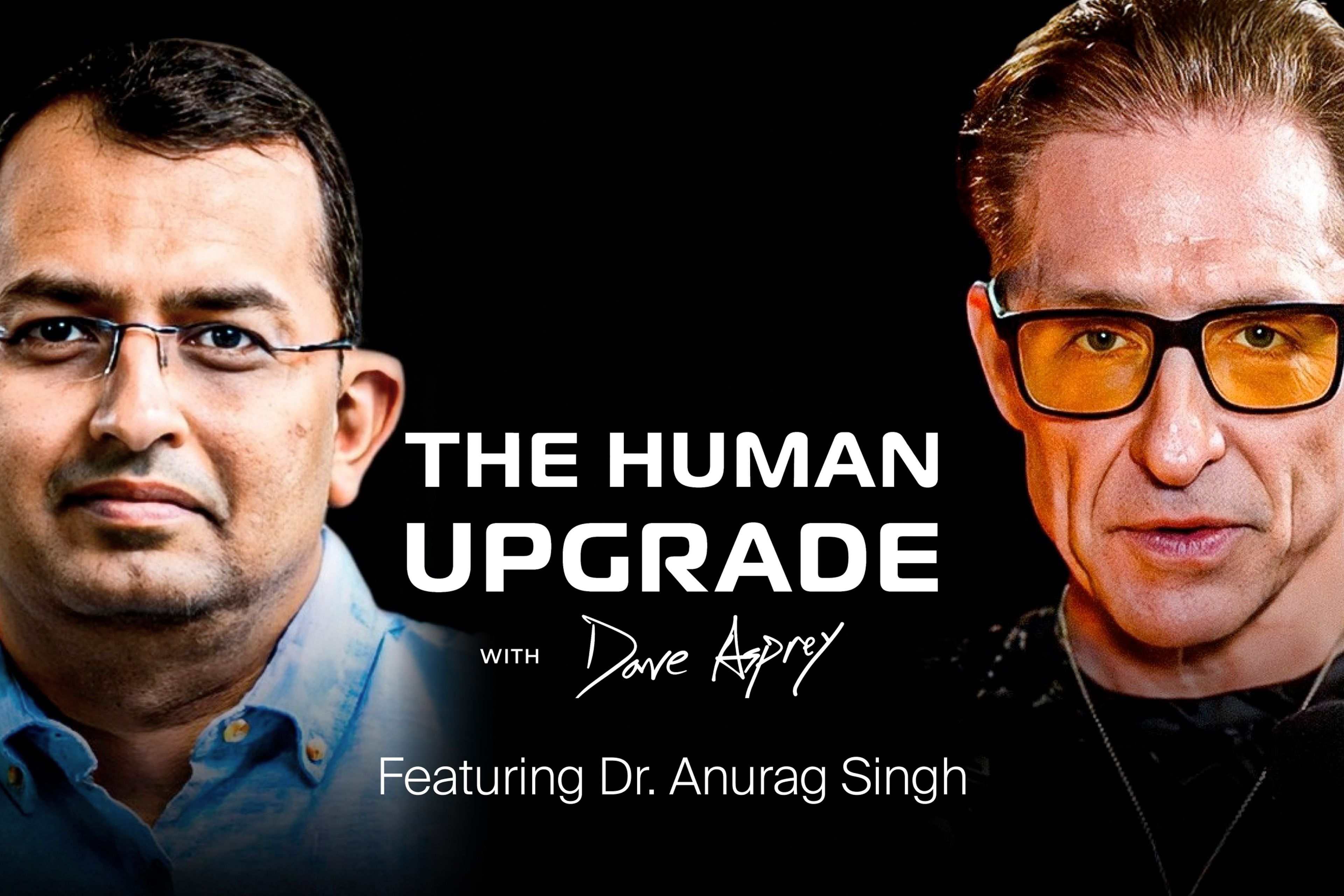
What to know
Dave Asprey, often dubbed the “father of biohacking,” is a big believer in mitochondrial health being the foundation of longevity.
Mitochondrial decline begins in the 30s and 40s, accelerating with age, but can be mitigated through targeted interventions like Mitopure®.
Urolithin A, a postbiotic derived from certain foods, stimulates mitophagy, promoting the regeneration of healthy mitochondria and enhancing cellular energy.
While lifestyle factors like exercise and diet are crucial, supplementation with Mitopure® offers another method to support mitochondrial function, especially for those with limited natural Urolithin A production.
Mitochondrial health impacts various systems, including heart, brain, immune function, fertility, and skin.
In a recent episode of The Human Upgrade podcast, Asprey sits down with Dr. Anurag Singh, an internal medicine physician, immunology PhD, and Chief Medical Officer at Timeline. With more than 50 randomized clinical trials led and 15+ patents to his name, Dr. Singh is a leading authority on mitochondrial and cellular health.
Dave Asprey, widely recognized as the “father of biohacking,” has long championed the idea that optimizing mitochondrial function is the foundation of better health, energy, and performance. In this conversation, he and Dr. Singh dive deep into the science of mitochondria and how Mitopure® is changing the game for anyone looking to reclaim their cellular vitality.
Here are some standout moments from this expert conversation, where they break down the science and practical steps to supercharge your mitochondrial health and longevity.
Key Insights from Dr. Anurag Singh on Dave Asprey’s Podcast
Mitochondria: The Foundation of Energy, Health, and Longevity
Mitochondria are having a moment, and for good reason. These tiny organelles generate over 90% of cellular energy, required for almost every bodily function, from muscle contraction to hormone production to memory formation. When these organelles falter, so does everything else.[1]
Asprey: “My view on longevity and cognitive performance is all about mitochondria. Fix the mitochondria. Everything is better because they're foundational.”
Mitochondrial dysfunction is recognized as one of the core hallmarks of aging. Asprey continues.
Asprey: “You think fatigue is normal. You think muscle loss is aging. You think low energy is your fault. It’s not. It’s your mitochondria. When your mitochondria collapse, your strength disappears. Your mind slows, your future narrows.”
Dr. Singh: “Irrespective of what cell or organ. You repair the mitochondria, you can rejuvenate them.”
That’s where the optimism lies. Asprey and Dr. Singh emphasize that mitochondrial decline is not irreversible. You can protect these little organelles to prevent these downstream effects.
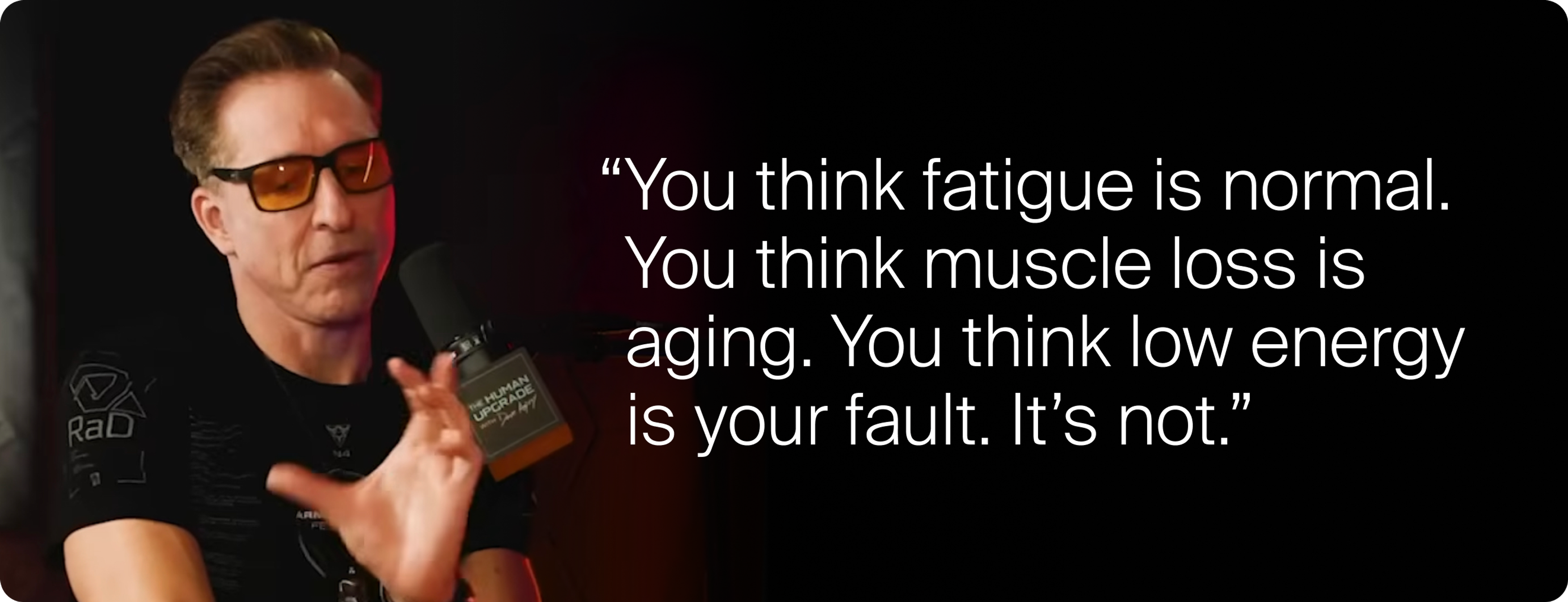
When Does Mitochondrial Decline Begin?
Dr. Singh discusses how mitochondrial health accelerates later in life.
Dr. Singh: “Mitochondrial decline is always happening... The decline takes a drastic shift towards more accumulation of the bad ones starting in our late thirties, forties… I would say around early forties is when there’s a slight uptick into the decline of mitochondrial capacity. And then it accelerates really towards the 6th, 7th decade of life, around the 60-year age mark.”
For women, mitochondrial decline becomes especially pronounced post-menopause. Asprey highlights this:
Asprey: “And for women, it hits even harder. New research shows that after menopause, mitochondrial decline accelerates. You lose muscle, your energy crashes, and you age from the inside out. But it's not a death sentence, it's just a setback, and it's reversible.”
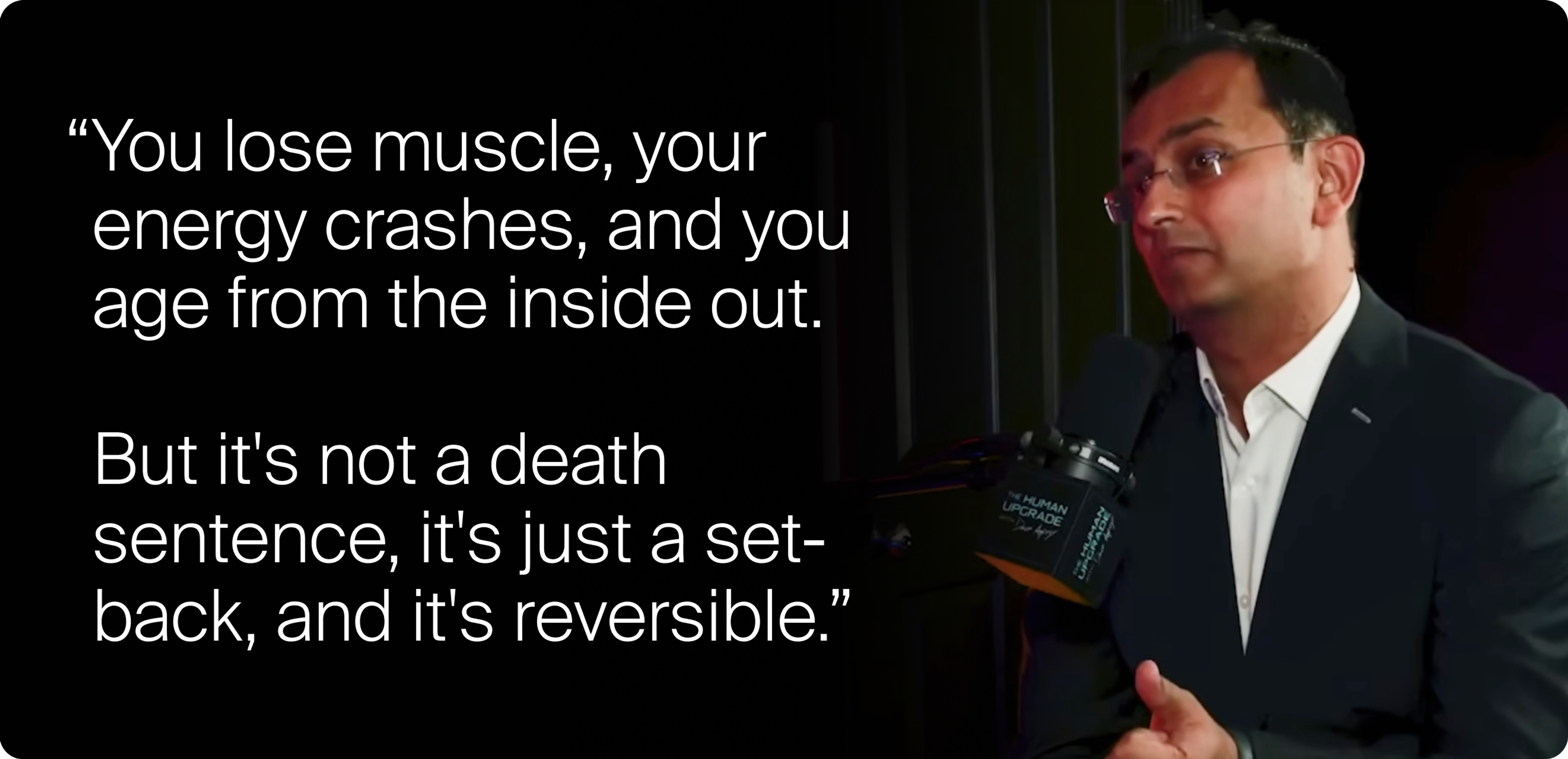
How To Promote Mitochondrial Health
Dr. Singh discusses how mitochondria regenerate through a process called mitophagy, the clearing out of damaged mitochondria to make way for mitochondrial biogenesis (the creation of new ones).[2] To trigger this, the body needs the right signals, and one of the most promising comes from a molecule called Urolithin A.[3]
Urolithin A: Nature’s Answer to Mitochondrial Decline
Urolithin A is a naturally occurring postbiotic produced by our gut bacteria when we consume certain polyphenol-rich foods, such as pomegranates. As Dr. Singh and his team discovered, Urolithin A plays a vital role in supporting mitophagy and mitochondrial health.[4]
However, the challenge is that the majority of people don’t have the gut composition required to produce enough Urolithin A.[5] And even for those of us who can produce Urolithin A, chances are you are not eating enough of the dietary precursors to make meaningful quantities.
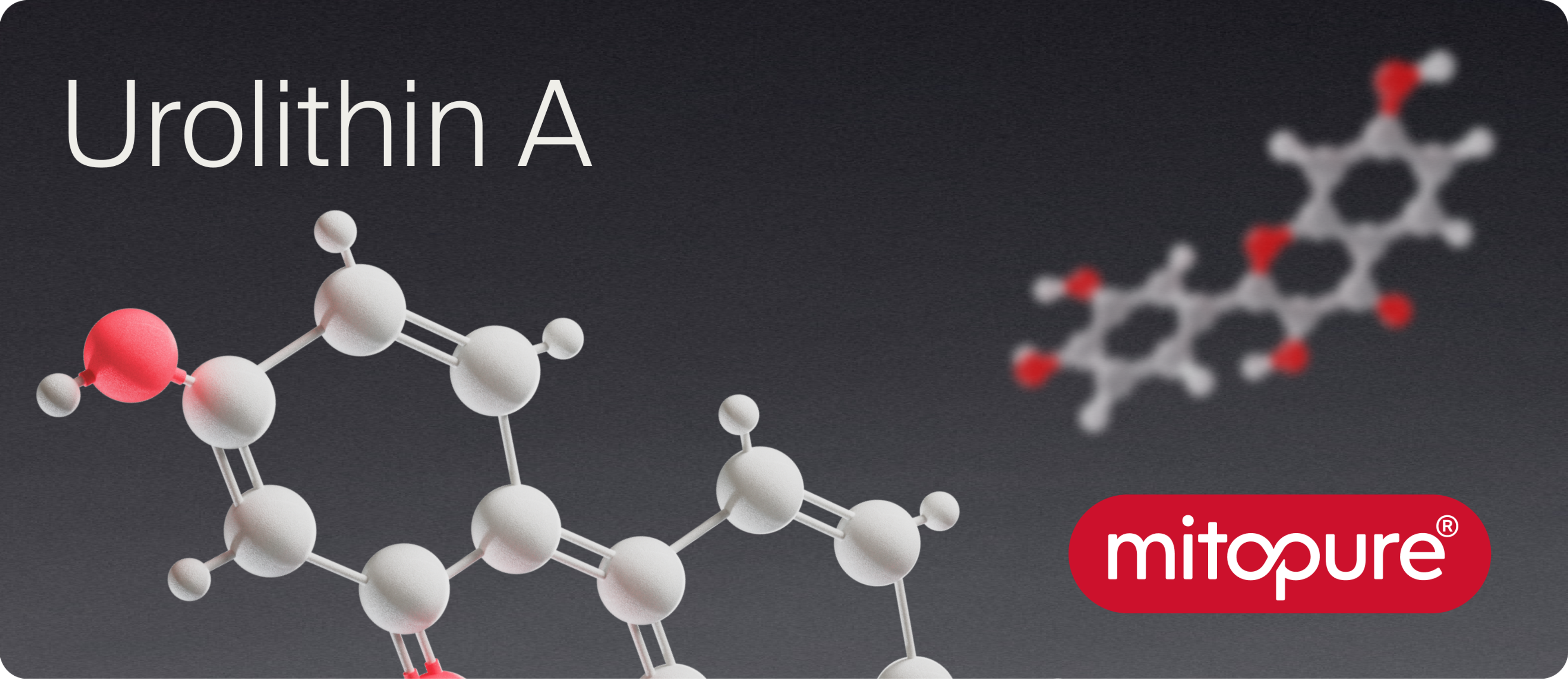
Mitopure: The Best Way To Supplement Urolithin A
Asprey points out that Dr. Singh and his team spent over a decade developing Mitopure®, the first clinically-tested form of Urolithin A that delivers a reliable dose, regardless of your microbiome composition.[6]
Asprey: “And the reason I was so excited when your first papers came out, you've been secretly working in a lab for 10 years to figure out a compound that pretty much nobody makes enough of in their gut. That radically rejuvenates them. ”
Dr. Singh: “The molecule induces mitophagy. So it cleans out the faulty mitochondria, and in about a month, we start seeing what we call mitochondria biogenesis.”
By enhancing this natural cellular cleaning process, Mitopure supports mitochondrial health and energy production at the cellular level.
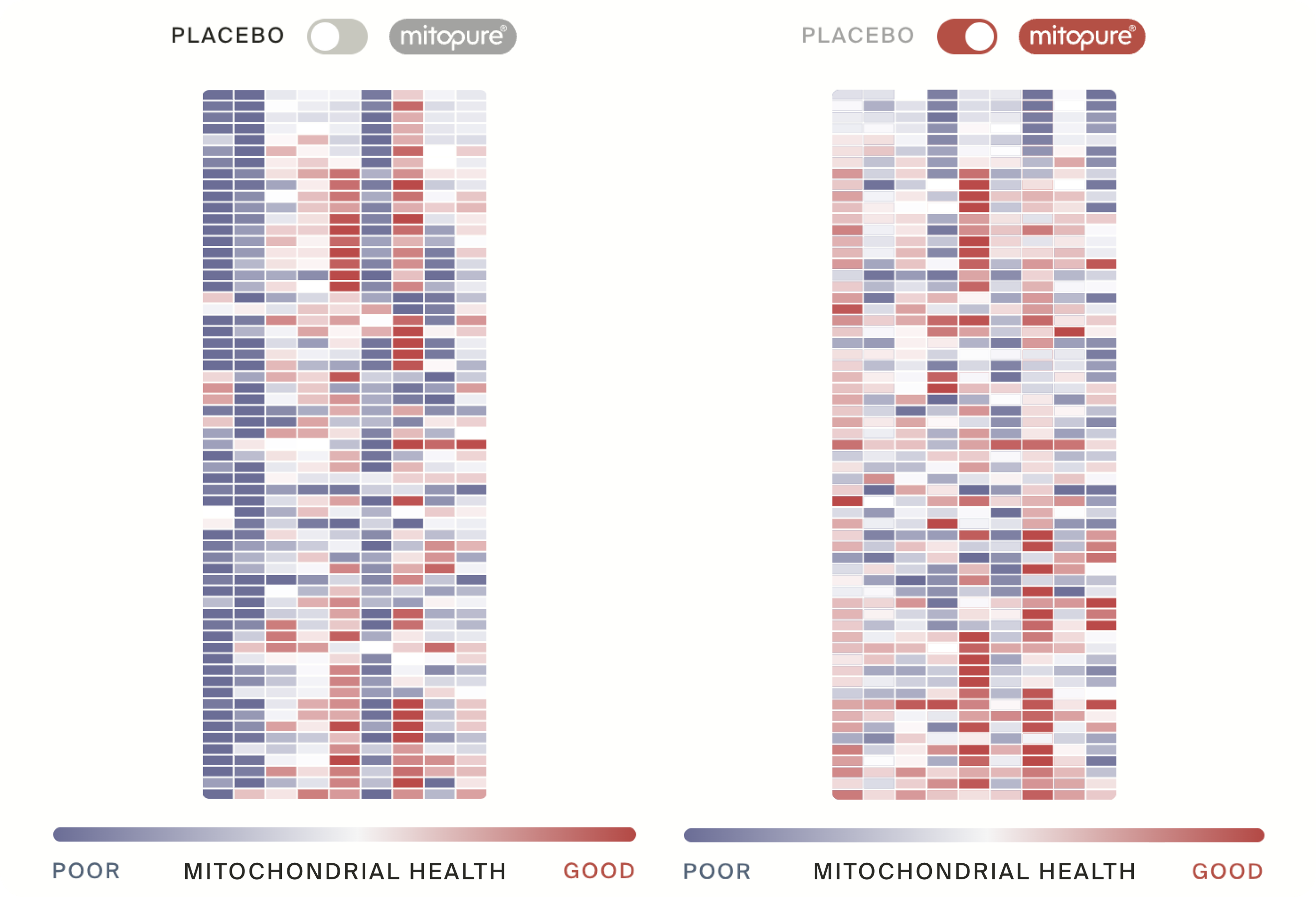
Asprey: “His research uncovered a lost process, something we once triggered naturally, a way to clear broken mitochondria, a way to rebuild the energy at the cellular level, a way to slow aging at the source. He didn't invent it. Nature did. And now we can bring it back.”
Dr. Singh and Asprey emphasize that with Mitopure, you are tapping into a natural biological process that’s just been diminished by modern life.

Tracking Mitochondrial Renewal: The Role of PGC-1α
Dave: “If I was gonna get another tattoo on this bicep... I might choose PGC-1α. Talk to me about PGC-1α. Why do I care, and what does Timeline do to it?”
One of the earliest signs of mitochondrial improvement is a rise in PGC-1α, a master regulator of mitochondrial biogenesis. It acts as a molecular signal that the body is regenerating its mitochondrial network, often in response to energetic demands like exercise.[7]
While physical activity is a well-established way to stimulate PGC-1α, and is foundational to health, Dr. Singh’s research shows that Mitopure offers a non-exercise route to mitochondrial rejuvenation by enhancing mitophagy first.
The Impact of Mitochondria on System Health
Dr. Singh and Asprey discuss some of the research outlining how mitochondrial health can influence the different organs and systems of our body, starting with a discussion on the heart.
Mitochondria and Heart Health
Mitochondria are more than just cellular batteries: they are fundamental to cellular health and the underlying cause of most disease.
Dr. Singh: “The three cells that have the highest abundance of mitochondria are the brain and the neurons, the skeletal muscle, and cardiac muscle. Kidney is another one... What we saw, looking at the hearts of people who had died of heart failure, was so much mitochondrial damage in these hearts.”
Timeline’s research is now expanding into cardiac health, with promising results in animal models.
Dr. Singh: “We tried to see if we could rescue some of these features of cardiac aging or heart failure [in animal models] by giving Mitopure supplementation [in preclinical models]. And we were able to see about a 20% reversal, a protective effect of Mitopure.”
New preclinical data in mouse models show promise for Urolihtin A and markers of cardiovascular risk.[8]
Mitochondria and Brain Health
Given that neurons are among the most mitochondria-dense cells in the body, it’s no surprise that mitochondrial dysfunction is increasingly linked to neurodegenerative conditions like Alzheimer’s and Parkinson’s.[9]
Asprey: “The second place would be neurons in the brain. So it stands to follow and I would bet, and I am betting with my behaviors that taking Timeline is also going to be protective of Alzheimer’s and Parkinson’s.”
While Timeline itself is not conducting these trials, academic institutions are and animal studies look promising.
Dr. Singh: “There's a group in Harvard actually that came to me and said, we want to do a trial because we did the screen of 4,000 compounds and the top one that hit because it's safe and it hits these two pathways is Urolithin A.”
Asprey: “Wow, the very top out of 4000.”
Asprey connects the dots between mitochondrial health and the most feared diseases of aging:
Asprey: “What are the four killers from Superhuman? It’s cardiovascular disease. Oh, mitochondria. Diabetes. Oh, mitochondria. Alzheimer’s. Oh, mitochondria. Cancer. Oh, mitochondria.”
Dr. Singh and Asprey even move on to discuss consciousness and how our mitochondria may influence our ability to meditate.
Asprey: “Do you think mitochondria are related to consciousness evolutionarily?”
Dr. Singh: “These were bacteria. They integrated with the host into their, they have their own DNA... when you get brain fog and you're not thinking clearly, it's all mitochondria.”
Asprey: “And my data is that people can do these advanced meditation practices for two and a half times longer with mitochondrial stimulation… I will suggest to people who come to 40 Years of Zen that they should be on Timeline at least two months before they go in. 'Cause look, if you're gonna spend almost $20,000 and five days with a team of neuroscientists upgrading your brain, maybe your mitochondria should be all the way on.”
Research in humans still needs to be completed to understand the benefits of Urolithin A on brain function.

Mitopure Gummies
4.7 · 677 reviews
A strawberry-flavored dose of cellular energy
Mitochondria and Immune Health
With his PhD in immunology, Dr. Singh sheds light on a critical but often overlooked piece of the longevity puzzle: T cells, the frontline warriors of our immune defense, are intimately tied to mitochondrial health.
Dr. Singh: “As we age, there are certain army of immune cells called the T cells... They decline because there's an organ called the thymus that just disappears around 30, 40s and you're left with just the bag of goodies that you were dealt with. What we'd see actually is [Mitopure] supplementation at the higher dose... These cells come back, they have better quality mitochondria.”
The implications are enormous. Stronger immune function in older adults could mean better defense against infections.

Asprey: “Studies are abundantly clear... showing your mitochondria are going to be happier. And I know that means you're going to at least have healthspan if that's your goal. My goal is to have healthspan and extra longevity. And you have to have mitochondria to do it.”
Mitochondria and Fertility
The conversation closes with a discussion of mitochondrial health and fertility, a topic close to Asprey’s heart.
Asprey: “What do we know about mitochondria, Timeline and fertility in men or women?”
Dr. Singh: “Early, early days, early research... One in Brazil and one in Portugal. One has been working on male infertility. One has been working on female infertility. What they do see in male infertility is… culturing infertile sperms with different doses of Urolithin A. And what they'd see is that the motility of the sperms gets better.”
In men, sperm motility, a key indicator of fertility, is heavily dependent on mitochondrial energy output.
Dr. Singh: “And in ovarian aging or in female infertility. There's two groups actually. One in Princeton, where they're showing that ovarian aging is very closely tied to mitophagy defects and mitochondrial dysfunction. This opens up exciting possibilities for the future-where mitochondrial optimization could support not just longevity and performance, but also reproductive health.”
Asprey: "If your mitochondria are working better three months before you get pregnant or longer... your body will do a better job of picking the right egg and the survival rate of your child will be through the roof and the chances of birth defects goes down."
While human trials are just beginning, the preclinical data is compelling and points to a broader redefinition of fertility as a bioenergetic process.
Mitochondria and Skin Health
Dr. Singh: "Skin cells also have mitochondria. They also go down in their energetic capacities... Poor mitochondrial health as we age… skin being the organ that has a lot of environmental toxins to adjust to. So it's like a double whammy. And what we see in our studies is mitopure containing topical products or cosmetics... can reverse a lot of this dual damage, so the inflammation and the mitochondrial damage."
Timeline’s skincare line is built around this insight, combining Mitopure with advanced peptides, niacinamide and other powerful actives.
Dr. Singh: "Now we have a range of [products]. We have a day cream. We have a night cream, and now we have a new eye cream... They’ll do an amazing job at a cellular level hitting on these MMPs, [a group of enzymes]... that degrade collagen causing your wrinkles around your eye area. And they just keep your skin better hydrated. Just because now you have better cellular health and skin health."

Beyond surface-level hydration or collagen support, Timeline’s approach targets the source of skin health.
Dr. Singh: "We are now taking skin biopsies... doing electron microscopy to actually see if we have rewired the mitochondria in the skin. And at what level. Is it the dermis? Is it the epidermis? Cool. So that's where we are headed."
Dosing with Timeline
Asprey, always a biohacker at heart, asks what everyone wants to know.
Dave: “This is my sixth Timeline. What's my upper limit? I like these.”
Dr. Singh: “So we've gone, uh, two grams. So that would be eight of these gummies. There is no real upper limit. I mean, this is a natural molecule, evolutionary. Everybody made it, but we've just lost, you know, two things. We've lost our microbiome, and we've stopped giving the microbiome the good stuff.”
While there is no known toxicity at typical doses, benefits appear to plateau after 1000 mg daily. 500-1000 mg is an effective dose to see real-world benefits.
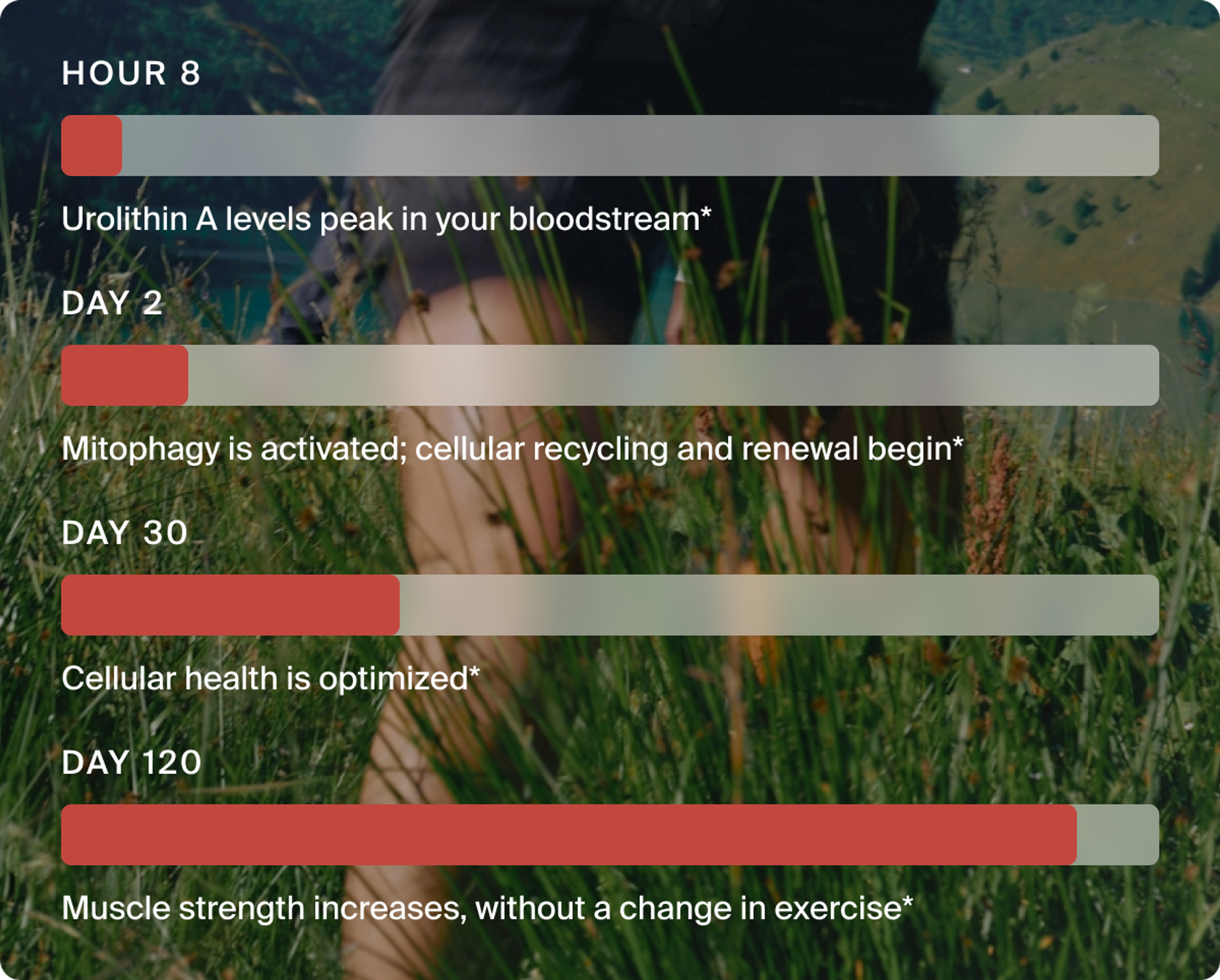
The Timeline: What to Expect When You Start Mitopure
Mitopure is not a stimulant, but instead a supplement that focuses on long-term health. The process of mitophagy and mitochondrial biogenesis takes time.
Asprey: “Some mitochondrial stimulators; acetyl carnitine, PQQ-are widely available. You feel 'em right away. But with Timeline, most people don't feel it. It takes about two months.”
Dr. Singh: “This is not a magic pill that suddenly, you know, in a week or two weeks will start doing everything like you were saying with the other nutrients.”
It takes time to renew the mitochondria, but what you get is sustained and lasting results.
The Bottom Line
Mitochondria may be small, but their impact on your energy and long-term health is massive. As Dr. Singh and Dave highlight, optimizing mitochondrial function isn’t just about feeling better today, it’s about safeguarding your future. With groundbreaking research, clinically validated interventions like Mitopure, and a better understanding of how cellular energy drives everything from immunity to aging, we’re entering a new era of health. The takeaway? Your mitochondria matter. And now, you have the tools to do something about it.
Authors

Written by
Freelance writer

Reviewed by
Director Science Communications
References
- ↑
Salin, K., Villasevil, E. M., Anderson, G. J., Lamarre, S. G., Melanson, C. A., McCarthy, I., Selman, C., & Metcalfe, N. B. (2019). Differences in mitochondrial efficiency explain individual variation in growth performance. Proceedings. Biological sciences, 286(1909), 20191466. https://doi.org/10.1098/rspb.2019.1466 (https://www.google.com/url?q=https://doi.org/10.1098/rspb.2019.1466&sa=D&source=docs&ust=1749156782550657&usg=AOvVaw2EqnLped0ropiYL19uVxfE)
- ↑
Chatzinikita, E., Maridaki, M., Palikaras, K., Koutsilieris, M., & Philippou, A. (2023). The Role of Mitophagy in Skeletal Muscle Damage and Regeneration. Cells, 12(5), 716. https://doi.org/10.3390/cells12050716 (https://www.google.com/url?q=https://doi.org/10.3390/cells12050716&sa=D&source=docs&ust=1749060922380524&usg=AOvVaw1r6xGnjeFQq4nl_5k5HEre)
- ↑
Singh, A., D'Amico, D., Andreux, P. A., Fouassier, A. M., Blanco-Bose, W., Evans, M., Aebischer, P., Auwerx, J., & Rinsch, C. (2022). Urolithin A improves muscle strength, exercise performance, and biomarkers of mitochondrial health in a randomized trial in middle-aged adults. Cell reports. Medicine, 3(5), 100633. https://doi.org/10.1016/j.xcrm.2022.100633 (https://www.google.com/url?q=https://doi.org/10.1016/j.xcrm.2022.100633&sa=D&source=docs&ust=1749060922381668&usg=AOvVaw3KhrCdz-mi_IWMAEc_QLDr)
- ↑
Singh, A., D'Amico, D., Andreux, P. A., Fouassier, A. M., Blanco-Bose, W., Evans, M., Aebischer, P., Auwerx, J., & Rinsch, C. (2022). Urolithin A improves muscle strength, exercise performance, and biomarkers of mitochondrial health in a randomized trial in middle-aged adults. Cell reports. Medicine, 3(5), 100633. https://doi.org/10.1016/j.xcrm.2022.100633 (https://www.google.com/url?q=https://doi.org/10.1016/j.xcrm.2022.100633&sa=D&source=docs&ust=1749060922382835&usg=AOvVaw2trtc2S_xGC-E-TtzR520g)
- ↑
Singh, A., D'Amico, D., Andreux, P. A., Dunngalvin, G., Kern, T., Blanco-Bose, W., Auwerx, J., Aebischer, P., & Rinsch, C. (2022). Direct supplementation with Urolithin A overcomes limitations of dietary exposure and gut microbiome variability in healthy adults to achieve consistent levels across the population. European journal of clinical nutrition, 76(2), 297–308. https://doi.org/10.1038/s41430-021-00950-1 (https://www.google.com/url?q=https://doi.org/10.1038/s41430-021-00950-1&sa=D&source=docs&ust=1749060922384914&usg=AOvVaw2bUma2B-LaWmI8X08AMES1)
- ↑
Singh, A., D'Amico, D., Andreux, P. A., Dunngalvin, G., Kern, T., Blanco-Bose, W., Auwerx, J., Aebischer, P., & Rinsch, C. (2022). Direct supplementation with Urolithin A overcomes limitations of dietary exposure and gut microbiome variability in healthy adults to achieve consistent levels across the population. European journal of clinical nutrition, 76(2), 297–308. https://doi.org/10.1038/s41430-021-00950-1 (https://www.google.com/url?q=https://doi.org/10.1038/s41430-021-00950-1&sa=D&source=docs&ust=1749060922386873&usg=AOvVaw2MYLAcEItxRfqT4aWe4GoT)
- ↑
Abu Shelbayeh, O., Arroum, T., Morris, S., & Busch, K. B. (2023). PGC-1α Is a Master Regulator of Mitochondrial Lifecycle and ROS Stress Response. Antioxidants (Basel, Switzerland), 12(5), 1075. https://doi.org/10.3390/antiox12051075 (https://www.google.com/url?q=https://doi.org/10.3390/antiox12051075&sa=D&source=docs&ust=1749060922388017&usg=AOvVaw3_LgnbqEf0WDsyrF4rBZlp)
- ↑
Liu S, Faitg J, Tissot C, Konstantopoulos D, Laws R, Bourdier G, Andreux PA, Davey T, Gallart-Ayala H, Ivanisevic J, Singh A, Rinsch C, Marcinek DJ, D'Amico D. Urolithin A provides cardioprotection and mitochondrial quality enhancement preclinically and improves human cardiovascular health biomarkers. iScience. 2025 Jan 14;28(2):111814. doi: 10.1016/j.isci.2025.111814. PMID: 40034121; PMCID: PMC11875685.
- ↑
Hoekstra, J. G., Montine, K. S., Zhang, J., & Montine, T. J. (2011). Mitochondrial therapeutics in Alzheimer's disease and Parkinson's disease. Alzheimer's research & therapy, 3(3), 21. https://doi.org/10.1186/alzrt83 (https://www.google.com/url?q=https://doi.org/10.1186/alzrt83&sa=D&source=docs&ust=1749060922389501&usg=AOvVaw3z86pNAnnzDwAaBZzwPe8K)
Disclaimer
The information in this article is for informational purposes only and should not be taken as medical advice. Always consult with your medical doctor for personalized medical advice.

·
Nutrition·
Studies·
New Study: Urolithin A Revitalizes an Aging Immune System
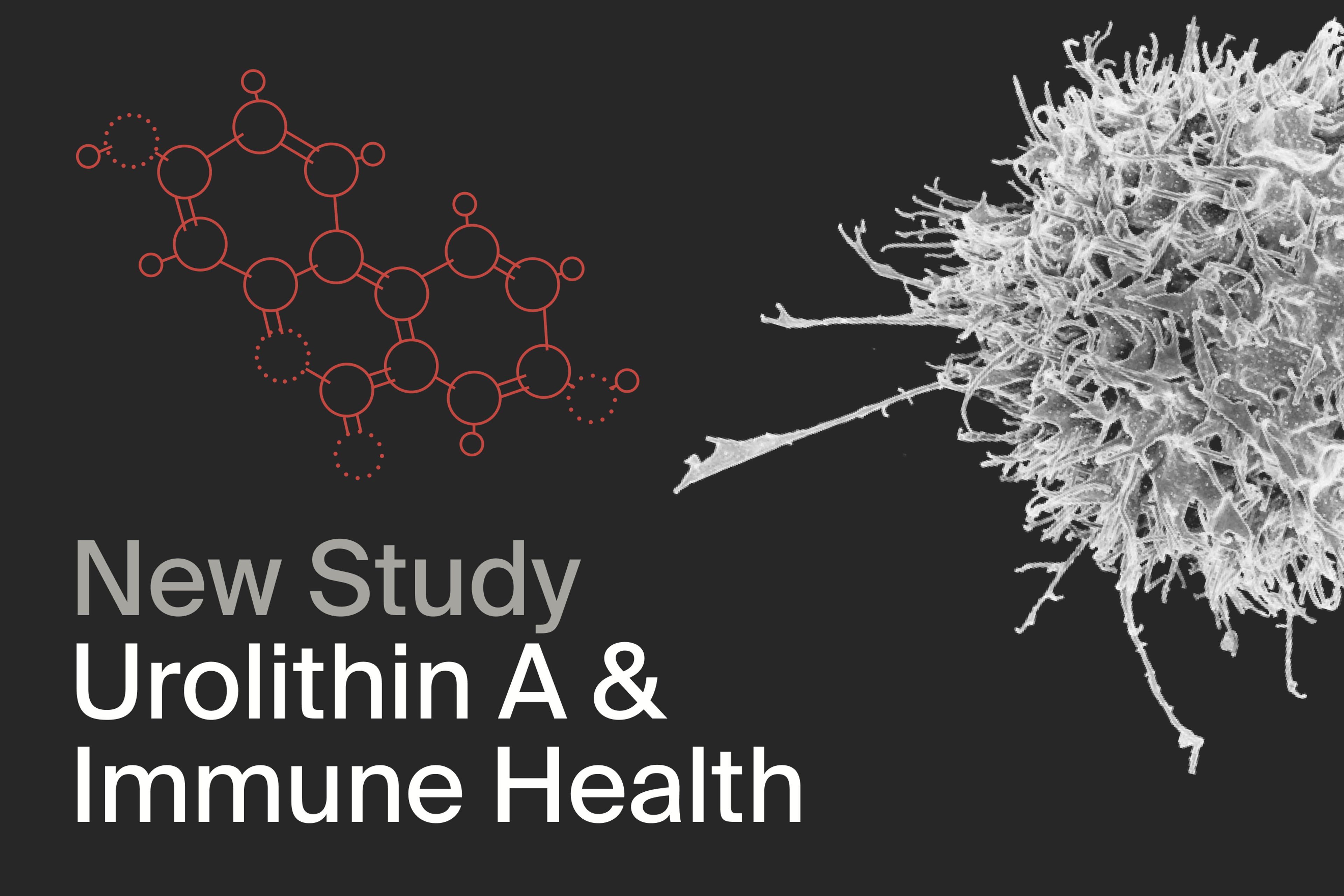
·
Nutrition·
Studies·
Urolithin A and Immune Health, A Breakthrough Discovery

·
Nutrition·
Studies·




